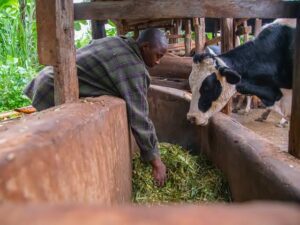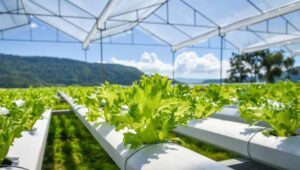Last updated on March 2nd, 2024 at 05:54 pm
Beetroot farming in Kenya can be a lucrative business. You can earn up to Ksh100,000 per acre of land planted with beetroots. The market size for the vegetables is also growing due to increasing demand from both local and international consumers.
Cost of starting beetroot farming in kenya
You will need to invest in the following:
- Beetroot seeds. The cost of these depends on the variety you want, but it’s usually between Ksh 10,000 and Ksh 15,000 per kilogram.
- Land for beetroot farming. The cost of land can vary widely depending on where you get it and how much you buy (small plots are cheaper). However, if you’re starting small with just one acre (0.4 hectares), this may be affordable for your budget–and if not, there are many ways to find free or cheap land that could make all the difference.
- Farming equipment such as tractors and plows for digging trenches around rows of plants so runoff water doesn’t flood them out during rainy season; sprayers for foliar spraying against pests like aphids; irrigation pumps plus hoses leading away from them toward individual beds planted with seedlings; etcetera ad infinitum ad nauseam… You’ll probably need at least some basic tools like shovels/spades too–but don’t worry too much about what exactly they look like because chances are good that whatever kind works best locally will be readily available nearby anyway.”
Also read: Sugar Beet Farming in Kenya complete guide
Benefits and Nutrients of beetroot farming in Kenya
Beetroot is a root vegetable that has a history of being used for medicinal purposes. It is also rich in nutrients and vitamins. Beetroot farming Kenya offers many benefits, including:
- Iron – one serving of beetroot contains about 11% RDA (Recommended Dietary Allowance) of iron which helps build red blood cells and improves the immunity system.
- Potassium – this mineral helps regulate blood pressure by balancing out sodium levels in the body, as well as regulating water retention within cells. It also aids digestion by promoting saliva production to break down food particles into smaller pieces before they enter your stomach where they can be digested properly.* Magnesium – this mineral plays an important role in building strong bones because it helps keep calcium molecules together during bone formation.* Folic acid – this B vitamin helps prevent birth defects when consumed during pregnancy; it’s also good for preventing heart disease later in life
Suitable areas for growing beetroot in Kenya
Beetroot is a cool season crop, which means it can be grown in areas with a long growing season.
The ideal temperature range for beetroot is 15 to 30 degrees celsius. However, it can tolerate temperatures as low as 5 degrees celsius and as high as 40 degrees celsius (1).
Beetroot needs rich soil that drains well and has good drainage properties; therefore you should avoid areas where there are waterlogged soils or heavy clay soils that retain water for long periods of time (2).
Also Read: Macadamia farming in Kenya complete guide
Preparing, Growing and Caring for beetroots
The first thing you need to do is prepare the soil. This can be done either by digging it up or adding organic matter and fertilizers to it. Next, sow beetroot seeds in rows spaced at least 60cm apart with each row being 20cm apart from its neighbors.
When planting beets
Make sure that they are not planted too deep as this will cause them not germinate properly or even die off completely…
If they do not have enough sunlight exposure on their leaves’ surface area which would mean less food production for these plants over time due to lack of photosynthesis process happening inside them so make sure you only plant them about 1 inch under ground level but not deeper than what I just mentioned above.
Once your seeds have been planted properly then all there is left for us now is waiting patiently until harvest time comes around which should take place within 4 months from when we first began working on this project together today (May 1st 2019).
Climatic and soil conditions for beetroot farming in Kenya
In order to cultivate beetroot, you need to consider the climate and soil conditions. The best season for growing beetroot is during cool dry seasons such as March-May.
In this period, there is enough water in the soil for plants to develop properly without getting dehydrated.
The best type of soil for growing beetroot is sandy loam because it drains well and retains moisture efficiently without becoming waterlogged or too dry.
Varieties of beetroot for planting in kenya
Beetroot varieties for planting in Kenya
There are many varieties of beetroot that can be planted in Kenya. The most popular ones are:
- Red Ace
- Rubine Red Ace
- Ruby Queen
How and when to harvest your beetroots
Beetroot is ready to harvest when the bulbous root has developed.
The leaves should be green and healthy, with no signs of yellowing or wilting.
Beetroots can be harvested at any time during their growth cycle, but they’re best if picked young: once they reach full size, they become woody and fibrous inside–not very pleasant to eat.
When you’re ready to harvest your beetroot crop (which may take anywhere from 3-4 months)
Simply pull up each plant by its stem with a garden fork or trowel by loosening soil around its roots first so that it doesn’t break off into pieces when pulled from ground level (this will also prevent unnecessary damage).
Place harvested plants in baskets lined with newspaper before bringing them inside where they’ll keep until needed;
This will help prevent dirt from getting on finished dishes like salads or soups later down line.
Market size and Opportunities for beetroot farming in Kenya
The market for beetroot is growing in Kenya, with demand increasing by 5% annually. There are several opportunities for farmers to grow this crop, including:
- Growing for the domestic market
- Growing for export markets such as Europe and North America
Beetroot farming in Kenya presents some challenges, however. Most notably, there are no subsidies or other incentives available to farmers who want to produce beetroot on their land.
Challenges and Solution of beetroot farming in Kenya
Beetroot farming in Kenya is a profitable business, but it has its challenges. The main problem is the pests that attack the crop and reduce its yield.
There are also other issues such as drought, which can cause huge losses to farmers who have invested heavily into their farms.
To solve these challenges and make your beetroot farm successful, you need to apply certain methods that will help you increase your yields while reducing costs and risks of failure at the same time.
Conclusion
The beetroot is a root crop, meaning that it can be grown all year long. If you live in an area that experiences cold winters or hot summers, your crop may not yield as much as someone who lives farther south.
The best time to plant beets is from March through May when the soil temperature has warmed enough for germination and growth of the young plants. You should also know how much sun your garden gets each day so that you can plan accordingly when making decisions about watering or fertilizing.
FAQS
How long do beetroot take to grow?
Beetroot typically takes 55 to 70 days to mature, depending on the variety and growing conditions. However, baby beets can be harvested as early as 35 days after planting.
How profitable is beetroot farming?
Beetroot farming can be profitable, especially if you have access to a market that demands the crop. The profitability of beetroot farming depends on various factors, including yield per acre, market prices, and production costs.
How much is a kilo of beetroot in Kenya?
The price of beetroot in Kenya varies depending on the location and season. On average, a kilo of beetroot can cost between Ksh 50 to Ksh 100 in local markets.
How much beetroot yield per acre?
The yield of beetroot per acre can vary depending on several factors, such as soil fertility, climate, and farming practices. On average, beetroot can yield between 15 to 20 tons per acre.
Does beetroot need a lot of water to grow?
Beetroot requires regular watering, especially during dry spells, to ensure optimal growth and yield. However, excessive water can lead to diseases and reduce yield.
What month does beetroot grow?
Beetroot can be grown year-round in areas with a mild climate. In areas with cold winters, beetroots are typically grown in spring and summer, while in warmer regions, beetroots can be planted throughout the year



